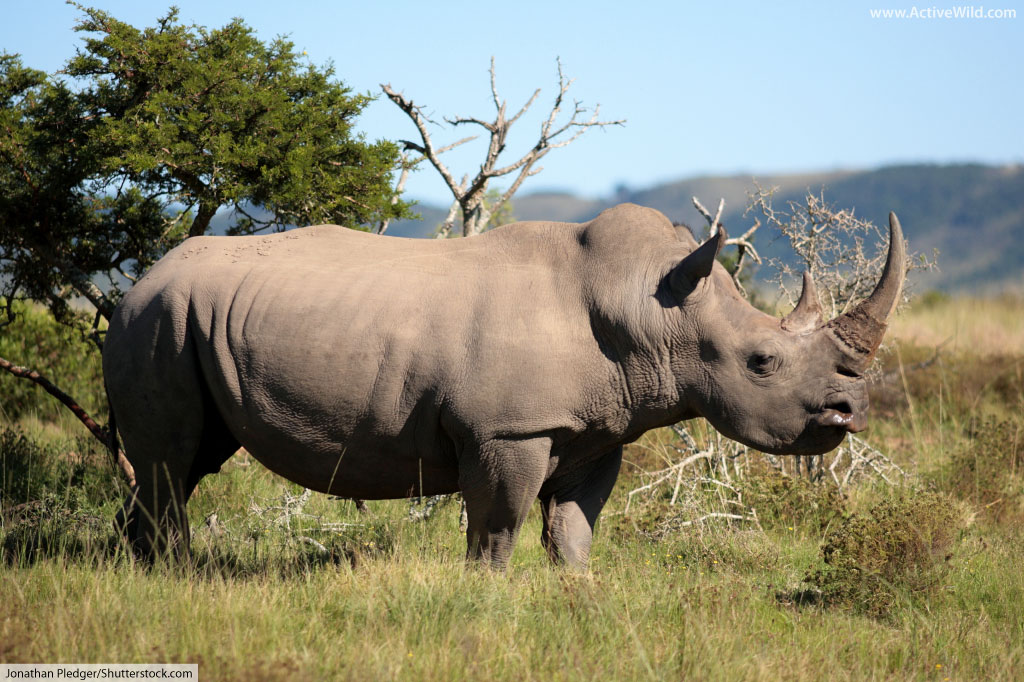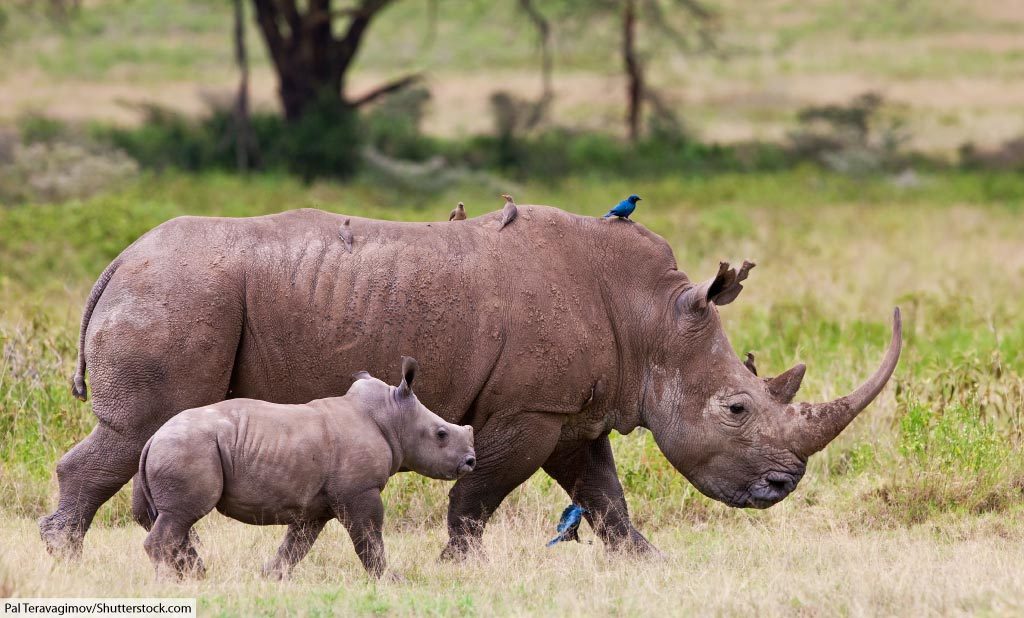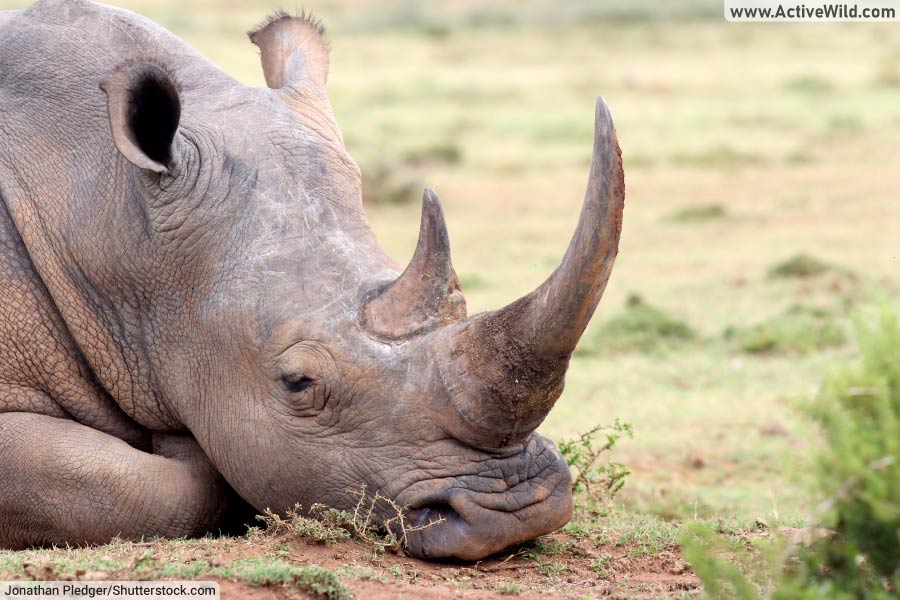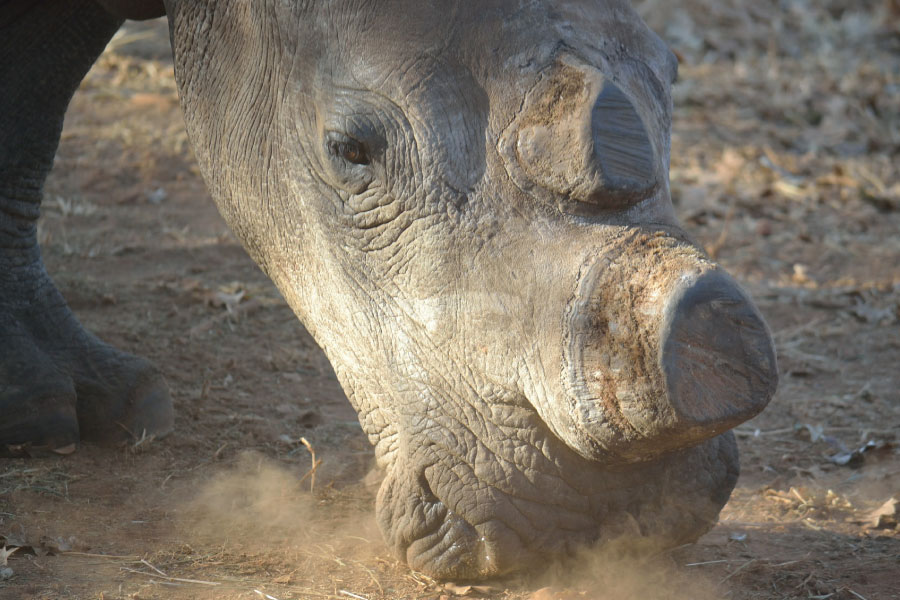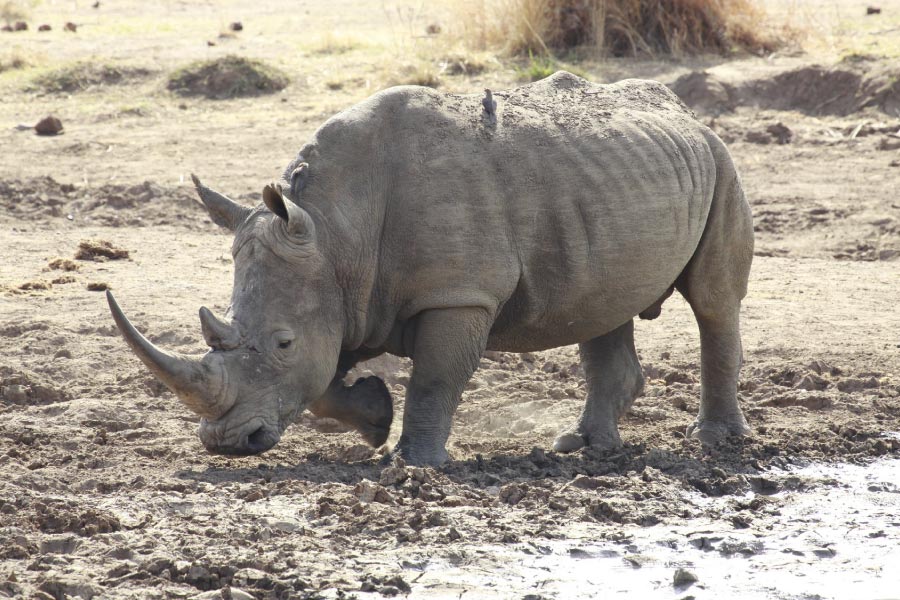The white rhinoceros is the largest of the five living rhino species. It is found in the savannas of southern Africa, where it spends most of its time grazing and wallowing in mud. The species is targeted by poachers, and at the time of writing only two northern white rhinos (one of the species’ two subspecies) are left, meaning the subspecies is virtually extinct.
Read on for more white rhino facts…
White Rhinoceros Facts At A Glance
- Other Name(s): White rhino, square-lipped rhinoceros
- Scientific name: Ceratotherium simum
- Type of Animal: Mammal
- Animal Family: Rhinoceratidae
- Where Found: Southern and eastern Africa
- Head-Body Length: 4 to 4.5 m (11.2 to 14.8 ft.)
- Shoulder Height:6 to 1.9 m (5.3 to 6.1 ft.)
- Average Weight: 2,300 kg (5,070 lb.), male; 1,700 kg (3,750 lb.), female
- Conservation Status: Near Threatened
Interesting White Rhino Facts
- A group of rhinos is known as a ‘crash’.
- Rhinos are members of the mammalian order Perissodactyla. Also known as the 'odd-toed ungulates', this group of hoofed mammals also contains the horses and the tapirs.
Meet The White Rhinoceros: Introduction
The white rhinoceros is fourth-largest land mammal in the world; only the three species of elephant are larger. It is one of two species of rhino found in Africa, and one of the five living species of rhino.
Rhino species
The white rhino has two subspecies: the southern white rhinoceros (C. s. simum) and the northern white rhinoceros (C. s. cottoni).
At the time of writing, there are only two northern white rhinoceroses left, both of which are female. With the only living male having died on March 19, 2018, the northern white rhinoceros subspecies is now functionally extinct.
How To Recognize A White Rhinoceros
The cameraman in the video below has a close encounter with a group of white rhinos...
The white rhinoceros is gray rather than white – it is thought that the animal’s misleading name comes from the Afrikaans* word ‘weit’ which means ‘wide’. This in turn refers to the animal’s wide lips.
* Afrikaans is a language widely-spoken in southern Africa.
The white rhino’s wide, flat lips are the best way of differentiating it from the black rhino – the only other rhino present in Africa – whose lips are pointed. Despite their names both species are a similar shade of gray!
The white rhinoceros has a bulky body with a large head and distinctive humped neck. Its legs are stumpy and have three toes. The skin is thick and deeply folded where its limbs join the body. The species is almost completely hairless.
The rhino has small eyes, long ears, and a wide, square-shaped mouth. Its nostrils are set further apart then those of any other land-based animal.
White Rhino Horns
The white rhino’s most distinctive feature is the two large horns which adorn its snout. These are made of keratin – the same natural protein out of which hair and fingernails are made.
The front horn, the larger of the two, has an average length of 60 cm (25 in), although those of some white rhinos can reach lengths of up to 150 cm (59 in). The rear horn grows to a length of around 56 cm (22 in.).
If broken, a rhino’s horn will eventually grow back – a process that can take up to three years for a rhino whose horn was removed near the base.
Because rhinos are illegally hunted for their valuable horns, in some parts of Africa conservationists deliberately de-horn the animals, thereby reducing their value to poachers.
Where Does The White Rhino Live?
Historically, the northern white rhinoceros was found in Uganda, Chad, Sudan, Central African Republic, and the Democratic Republic of the Congo (DRC). The subspecies was last seen in the Garamba National Park in DRC in 2006.
The southern white rhinoceros once ranged across southern Africa. Today, the subspecies is only found in Botswana, Namibia, South Africa, Swaziland, and Zimbabwe. The species has also been introduced to Kenya and Zambia.
White Rhinoceros Habitat
White rhinoceros habitat includes savanna, woodland and dense forest. The species is often found near a source of water.
White Rhino Facts: Behavior
Adult male white rhinoceroses are usually solitary. Females and young rhinos form herds containing up to 14 individuals.
Dominant bulls are territorial, marking their territories with urine and dung, and by scraping their horns against vegetation and on the ground.
The species is usually peaceful, but fights over territory can occasionally break out. Females can also be highly aggressive when defending their young. In a threat display, the rhino lowers its head, tilts its ears backwards and rubs its horn against the ground.
During the winter the white rhino is usually active during the day. In the warmer months, the species becomes more active at dawn and dusk, taking shelter during the hottest part of the day.
White rhinos are often seen wallowing in mud in order to cool down.
The white rhinoceros communicates using a range of vocalizations, including panting calls, grunts, snorts, squeals, bellows and growls. Calls are used during courtship, to indicate distress, and to maintain a bond between a mother and her calf. Male rhinos tend to be more vocal than females.
Although the white rhinoceros’s eyesight is poor it makes up for this by having an acute sense of smell. Scent appears to play a significant role in rhino communication.
The white rhinoceros is a surprisingly fast and agile runner, with a top speed of 50 km/h (31 mph).
White Rhinoceros Life Cycle
Although the white rhinoceros may breed any time of the year, in southern Africa mating commonly takes place between October and December, and in eastern Africa between February and June.
A dominant male with its own territory has the best chances of mating. A male may guard a female for up to 20 days before mating, blocking her way and squealing loudly if she tries to leave his territory.
After a gestation period of 16 months, the female gives birth to a single calf. The newborn calf weighs 40 to 60 kg (88 to 143 lb.) and is 50 to 65 cm (20 to 26 in) in length.
It takes up to 3 days for the calf to become steady on its feet, and around 6 weeks for its horns to become visible. It will double in size in around 6 months and is weaned after around 1 year.
Female white rhinos give birth every 2 to 3 years.
What Do White Rhinos Eat?
The white rhinoceros is herbivorous, and one of the largest animals that takes its food almost entirely by grazing. The animal mainly grazes on short grasses but will also consume leaves, stems, flowers, fruits, seeds, and nuts.
The rhino’s square-shaped lips are well suited for its grazing lifestyle. The species spends roughly half of the day eating and will typically drink twice a day.
White Rhino Predators
Due to its large size, thick skin and strength, not to mention its fearsome horns, the white rhino is a formidable opponent and is rarely targeted by predators (although there are occasional reports of attacks on rhinos by lions and hyenas). Even the species’ calves are relatively safe due to the mother’s aggressive protection.
Is The White Rhino Endangered?
The white rhinoceros is rated ‘Near Threatened’ by the IUCN.
The white rhinoceros is the most numerous of the five rhino species. A 2010 study found that there were an estimated 20,170 individuals living in the wild.
The northern white rhinoceros is now probably extinct in the wild. Only two captive females remain.
The biggest threat to the white rhinoceros is poaching. The species is hunted for its horns, which are used in traditional Chinese medicine and as ornaments.
The animal’s large size, poor eyesight and mostly unaggressive nature make it an easy target for poachers.
White Rhino Facts: Further Reading
- Discover more African animals: African Animals List with Pictures & Facts
- Become an animal expert: Animals: The Ultimate Guide to the Animal Kingdom
- Learn about more animals: A to Z Animals Pictures & Facts

